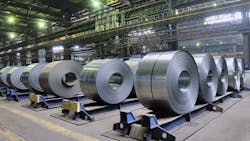Congressional Budget Office Sees Trade War Dragging on US Economy
U.S. trade barriers will hurt rather than help the economy, according to a new Congressional Budget Office forecast that’s at odds with President Donald Trump’s position on tariffs.
The levies -- imposed on items including steel, aluminum, and some Chinese goods -- will cut real gross domestic product by about 0.1% on average through 2029 and fuel “uncertainty among investors, which may further reduce U.S. output,” the non-partisan CBO said in a report Monday.
The CBO also estimates new tariffs will increase inflation, adding 0.1% to the personal consumption expenditures price gauge by 2022 and boosting prices for private investment by 0.5% over the period. By 2022, changes in trade policy will reduce real consumption by 0.1% and real private investment by 0.3%, researchers said.
“Like other price increases that result from taxes, those higher prices will reduce consumer spending by diminishing the purchasing power of consumer income and will reduce investment by making capital goods more expensive,” the CBO said. The negative effects of tariffs may be offset over time as some businesses relocate production to the U.S. from foreign countries, researchers added.
Trump has argued that trade wars are necessary to help boost manufacturing jobs and ensure competitors such as China play by global rules, with import tariffs on foreign goods increasing government revenue. Economists have disagreed, saying that higher goods prices could slow consumer spending and business investment while adding uncertainty as firms shift their sourcing to avoid the levies.
The CBO’s projections are based on current trade barriers in effect only, assuming that levies on certain Chinese goods won’t jump to 25% from 10% in March. Researchers also noted high uncertainty around the future of trade policy, which they said would affect their projections.
By Katia Dmitrieva
About the Author
Bloomberg
Licensed content from Bloomberg, copyright 2016.
